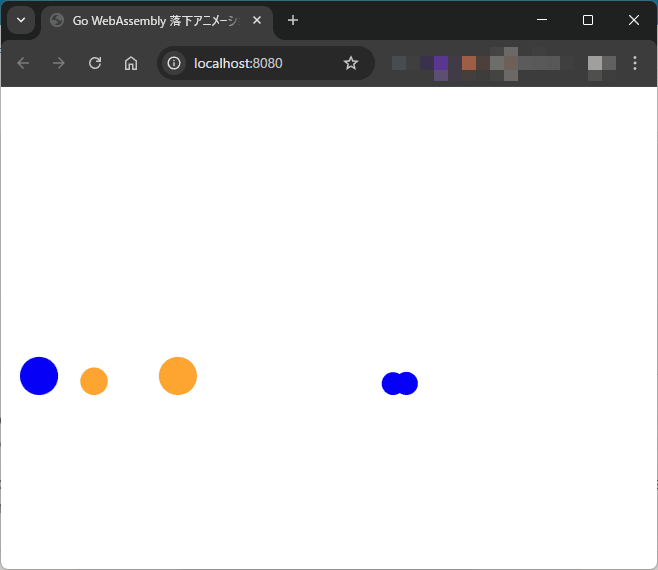まえがき ※【2025/2/28 追記】続きを書きました【Claude 3.7】Go言語でwasmのサンプルプログラムをAIに作らせて動かしてみる
Go言語でボール落下アニメーションのプログラムを書き、Wasmにコンパイルしてブログ上で動かしてみました。
Start
tinygoを使用した場合、非圧縮では約200KB、gzipで圧縮すると約80KB程度のファイルサイズになりました。
そもそも単純なプログラムで使用するパッケージは3種類のみのため、ファイルサイズが小さくなるのは当然ですが、
ちなみに有名なWebサービスであるFigmaもwasmを使用しています。
ボール落下アニメーションの作り方 では作り方について解説していきます。wasm-testフォルダ直下に作成してきます。
1
2
$ mkdir wasm-test
$ cd wasm-test
まずは、ボール落下アニメーションのプログラムをGo言語で作成します。
1
2
3
4
5
6
7
8
9
10
11
12
13
14
15
16
17
18
19
20
21
22
23
24
25
26
27
28
29
30
31
32
33
34
35
36
37
38
39
40
41
42
43
44
45
46
47
48
49
50
51
52
53
54
55
56
57
58
59
60
61
62
63
64
65
66
67
68
69
70
71
72
73
74
75
76
77
78
79
80
81
82
83
84
85
86
87
88
89
90
91
92
93
94
95
96
97
98
99
// main.go
package main
import (
"math/rand/v2"
"syscall/js"
"time"
)
type Ball struct {
X , Y float64
VY float64
Radius float64
Color string
}
var (
canvas js . Value
ctx js . Value
balls [] Ball
gravity float64 = 0.5 // 重力加速度
ground float64 = 300 // 地面の位置
width float64 = 500 // キャンバスの幅
height float64 = 400 // キャンバスの高さ
)
// 物理演算の更新処理
func updatePhysics () {
for i := range balls {
balls [ i ]. VY += gravity // 重力の影響を適用
balls [ i ]. Y += balls [ i ]. VY
// 地面に衝突した場合
if balls [ i ]. Y > ground - balls [ i ]. Radius {
balls [ i ]. Y = ground - balls [ i ]. Radius
balls [ i ]. VY = - balls [ i ]. VY * 0.7 // 反発係数
}
}
}
// 描画処理
func draw () {
// キャンバスをクリア
ctx . Call ( "clearRect" , 0 , 0 , width , height )
// 各ボールを描画
for _ , ball := range balls {
ctx . Call ( "beginPath" )
ctx . Call ( "arc" , ball . X , ball . Y , ball . Radius , 0 , 2 * 3.1415926535 )
ctx . Set ( "fillStyle" , ball . Color )
ctx . Call ( "fill" )
}
}
// requestAnimationFrame のコールバック関数
func render ( this js . Value , args [] js . Value ) interface {} {
updatePhysics ()
draw ()
js . Global (). Call ( "requestAnimationFrame" , js . FuncOf ( render ))
return nil
}
func main () {
r := rand . New ( rand . NewPCG ( uint64 ( time . Now (). UnixNano ()), 3 ))
// HTML の canvas 要素を取得
document := js . Global (). Get ( "document" )
canvas = document . Call ( "getElementById" , "myCanvas" )
if canvas . IsUndefined () {
js . Global (). Call ( "alert" , "Canvas要素が見つかりません!" )
return
}
ctx = canvas . Call ( "getContext" , "2d" )
// ボールを複数追加
for i := 0 ; i < 5 ; i ++ {
xx := r . Float64 ()
rr := r . Float64 ()
balls = append ( balls , Ball {
X : xx * ( width - 40 ) + 20 , // ランダムなX座標
Y : 0 , // 最初は上部
VY : 0 , // 初速度ゼロ
Radius : 10 + rr * 10 , // 10~20px のランダムな半径
Color : randomColor ( r ),
})
}
// アニメーション開始
js . Global (). Call ( "requestAnimationFrame" , js . FuncOf ( render ))
// 永久ループ
select {}
}
// ランダムな色を生成する関数
func randomColor ( r * rand . Rand ) string {
colors := [] string { "red" , "blue" , "green" , "purple" , "orange" }
return colors [ r . IntN ( len ( colors ))]
}
次に、上記Wasmプログラムをフェッチして実行するHTMLを作成します。
1
2
3
4
5
6
7
8
9
10
11
12
13
14
15
16
17
18
19
<!DOCTYPE html>
< html >
< head >
< meta charset = "utf-8" >
< title > Go WebAssembly 落下アニメーション</ title >
</ head >
< body >
< canvas id = "myCanvas" width = "500" height = "400" ></ canvas >
< script src = "wasm_exec.js" ></ script >
< script >
// Go の WebAssembly ランタイムの初期化
const go = new Go ();
// main.wasm を非同期で読み込み、実行する
WebAssembly . instantiateStreaming ( fetch ( "main.wasm" ), go . importObject ). then (( result ) => {
go . run ( result . instance );
});
</ script >
</ body >
</ html >
次に、Wasmをロードして実行するための tinygo 用のJSファイル(wasm_exec.js)をカレントディレクトリにダウンロードします。
1
$ docker run -v " $( pwd ) " :/go -e "GOPATH=/go" tinygo/tinygo:0.36.0 /bin/bash -c "cp /usr/local/tinygo/targets/wasm_exec.js /go/"
実行後、wasm_exec.jsがカレントディレクトリに作成されていればOKです。
注意点 このwasm_exec.jsはtinygo 0.36用のものになっています。goの公式の方を使用するとWebAssembly.instantiate(): Import #0 module="wasi_snapshot_preview1" error: module is not an object or functionというエラーになってしまうので、tinygo 0.36専用のwasm_exec.jsを使用しましょう。
tinygoでWasmのバイナリを作る では、tinygoを使ってコンパイルする手順を説明します。
なお、Goのバージョンによってはコンパイルエラーになる場合があるためできれば1.24.0を使用してください。
まず、tinygo 0.36をダウンロードしインストールします。(Ubuntu環境の場合)
1
2
wget https://github.com/tinygo-org/tinygo/releases/download/v0.36.0/tinygo_0.36.0_amd64.deb
sudo dpkg -i tinygo_0.36.0_amd64.deb
次に、プロジェクトを初期化します。
1
$ go mod init wasm-test
そして、tinygoでコンパイルします。
1
tinygo build -o main.wasm -target wasm .
これで、main.wasmが生成されます。
1
2
3
4
5
6
7
8
9
$ tree wasm-test
wasm-test
├── go.mod
├── index.html
├── main.go
├── main.wasm
└── wasm_exec.js
0 directories, 5 files
では、ローカル環境でWebサーバーを立ち上げて動作確認をしてみましょう。
1
python3 -m http.server 8080
サーバー起動後、http://localhost:8080
にアクセスします。
あとがき 思ったより簡単に動作したので、かなり作りやすくなっていると感じました。
本記事が何かしらの参考になれば幸いです。もふもふ-Xアカウント
